
LONDON TRANSPORT TD CLASSLeyland Tiger PS1 single-deckersThis page prepared by Ian Smith, created 18th September 1999.The post-war TD class Tigers could be thought of as the Leyland equivalent of the postwar T-class Regals. Or, looked at another way, the single-deck equivalent of the postwar Leyland STDs. They appeared in two variants: the first, the 1TD1s, had provincial style bodies by Weymann that were very similar to those built for the Central Area postwar Regals, while the later 1/1TD2 version had a doorless version of the Mann-Egerton bodies produced for the Country Area Ts. Both had 7.4litre direct injection Leyland diesel engines, driving through crash gearboxes. The Weymann buses: TD1-31 (Total 31)Construction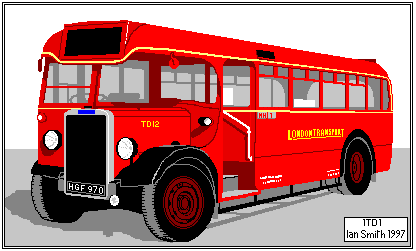 The chassis were Leyland Tiger PS1,
with a Leyland six cylinder 7.4 litre direct injection diesel engine,
and a 17ft 6in wheelbase.
The chassis were Leyland Tiger PS1,
with a Leyland six cylinder 7.4 litre direct injection diesel engine,
and a 17ft 6in wheelbase.
The bodies were by Weymann, their take-it or leave-it immediate postwar product, with sliding ventilators on the windows, and a deep underhanging destination box above the cab. The rear box was cocked up above the roofline, while the rear had a single window. The emergency door was on the offside. Points of difference from the sister T-class (apart from the chromium-plated Leyland radiator) were the square cab front and the plainer bonnet, (still without a number plate). They were 27ft long x 7ft 6in wide, and seated 33 originally, although this was later reduced to 32 to give the conductor extra standing space. Into service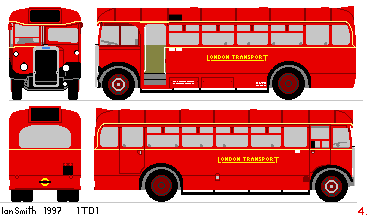 All thirty-one went for service to Muswell Hill (MH),
forming the primary allocation for hilly route 212,
starting in December 1946.
This route had just recently been given new 14T12 Regals,
but these had proved underpowered for the route,
and were displaced to Sidcup and Uxbridge.
Once all thirty-one had been delivered there was a small surplus at Muswell Hill,
and these were used to supplement the Renown six-wheelers on route 210.
All thirty-one went for service to Muswell Hill (MH),
forming the primary allocation for hilly route 212,
starting in December 1946.
This route had just recently been given new 14T12 Regals,
but these had proved underpowered for the route,
and were displaced to Sidcup and Uxbridge.
Once all thirty-one had been delivered there was a small surplus at Muswell Hill,
and these were used to supplement the Renown six-wheelers on route 210.
The Mann-Egerton buses: TD32-131 (Total 100)Construction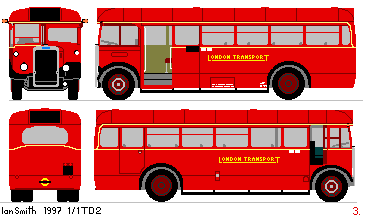 The younger vehicles had the same chassis as the first bunch,
but had a more modern style of body by Mann Egerton.
The front destination box was tidied up, with a straight roof-line,
and winding windows were fitted.
A door recess was included on the nearside,
behind the entrance, although this was never used on these buses
(unlike the Country 15T13s).
A polished aluminium radiator was fitted in place of the chrome-plated one,
and a proper fleet-number plate was affixed to the bonnet side.
A stencil holder for a route number was provided above the doorway,
although this was later replaced by one at the back of the recessed side
at waist level.
The younger vehicles had the same chassis as the first bunch,
but had a more modern style of body by Mann Egerton.
The front destination box was tidied up, with a straight roof-line,
and winding windows were fitted.
A door recess was included on the nearside,
behind the entrance, although this was never used on these buses
(unlike the Country 15T13s).
A polished aluminium radiator was fitted in place of the chrome-plated one,
and a proper fleet-number plate was affixed to the bonnet side.
A stencil holder for a route number was provided above the doorway,
although this was later replaced by one at the back of the recessed side
at waist level.
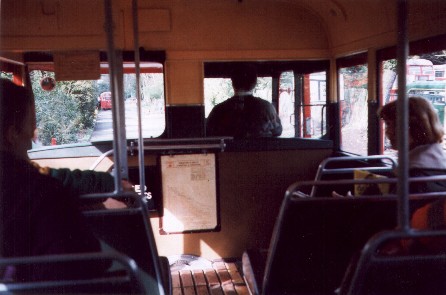
Inside, the TDs were laid out in sensible fashion.
The fare-table can be seen on the bulkhead,
and the later single seat at the offside front.
This gave the conductor more standing space than the original double seat.
Into serviceThe second batch began to arrive in the autumn of 1948, four going in October to Hornchurch for route 250 in rural Essex (with one 1T1 retained as a spare and for the peak - Sunday - service.)Enfield was the next recipient, new buses arriving through the remainder of 1948 for the Waltham Abbey routes 205 and 242. Again Ts had to be retained as spares and Sunday extras.
Hornchurch received some more over the turn of the year for the 247 and 248.
The 247 route was unusual in that Guy double-deckers were used on the in-town section,
but single-deckers were used for the full route out into the country.
December 1948 to February 49 also saw the new buses appearing in west London, this time in an urban setting. Route 211, operated by Hanwell garage (HW, soon to be renamed Southall) used ten TDs and up to six Ts (the peak requirement again being Sunday). North-west London received some in January, when four went to Harrow Weald for the 221. These sometimes appeared on lowbridge route 230, when a lowbridge ST or STL was unavailable.
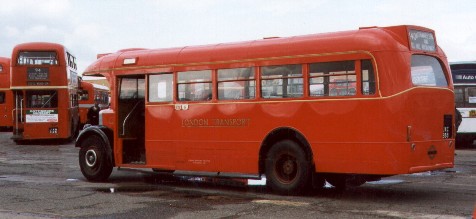
May and June 1949 saw nine go to Edgware for the 240 and 240A,
the former being interworked with RTs from Cricklewood
on the Golders Green - Mill Hill section.
The remainder of the TDs were allocated during the summer of 1949 to Tottenham (12) and Leyton (11) garages for the back-street but busy 236.
TD95 revisited the 236 on Easter Sunday 2006, visiting the garage at Leyton as well as the site of the erstwhile Dalston garage.Service changesOctober 1949 saw the Enfield allocation stretched by the introduction of a new 243 route to Upshire.April 1950 saw the end of TD operation on the 247, which became double-decked throughout. One TD went officially to the 248, and the others took over the 238, which had been T-operated since the Cubs ceased working it in July 1949.
The initial allocation of TDs had stretched them very thin. They were new buses, and expected to be reliable, while much of the system was making do with tired, war-worn and decrepit machinery. In many cases their spares were elderly Regals. So when any became spare they were eagerly seized upon. Route changes to the 201 and 264 at Kingston in June 1951 produced a few spares (the 264 had to revert to 1T1s, now available after refurbishment), and some of these were distributed to ease shortages at Edgware and Leyton. The rest went with some ex-GreenLine 6Q6s to replace the remaining LTLs on the Muswell Hill 210 route.
The TDs now found themselves working alongside some of the demoted 10T10s in their red bus livery, in some places, such as at Enfield and Kingston. April 1952 saw 14T12s (displaced from Sidcup by new RFs) going to Southall (HW) for the 211, releasing a number of TDs. Some went to Muswell Hill to replace the 6Q6s, and others to Kingston where they went into the single-decker pool, replacing Ts. The Muswell Hill allocation also allowed the replacement of 5Q5s from the 244 route.
May 1952 saw a shakeup in Surrey, when the new Norbiton garage opened. Norbiton assumed responsibility for the 201, which on paper had been a Kingston TD route, but used 14T12s and no TDs. Kingston kept its TDs, and used them increasingly in place of Qs on the 215 and 219 as well as the 216. The arrival of RFs at Muswell Hill for the 210 in September 1952 and the 212 in February 1952 saw the 244 completely converted to TD and then a flood of surplus TDs going west into Surrey, replacing Qs on Kingston's routes. These were followed by more from Enfield, when the 205, 243 and 242 were all double-decked after bridge-strengthening.
Other displaced TDs went to Loughton in February 1953, to convert the 254 from T operation. During the spring others went to Hornchurch, where the 252 was converted from 10T10s.
In August 1953 another new garage, North Street at Romford, opened to relieve over-crowding at Hornchurch, and the TD allocation for the 250 moved there. RetrenchmentThe postwar bus plan had not envisaged that the RFs would replace the TDs. but traffic growth, even by the mid-1950s, was not living up to expectations. The unforeseen growth of private car travel plus the effect of television on cinema-going were disturbing the forecasts. Progressively the TD routes were taken over by RFs, or other buses.Even an attempt to find a new niche for a TD, with a new route 256 between Woolwich and Shooters Hill, proved so successful that the TD was replaced by an RTL after a few days!
However, new route 215A was started from Kingston, branching off the 215 along narrow roads to Downside.
The surplus TDs were stored for a while,
then used to displace 14T12s from Norbiton,
taking over the 201, 206 and 264 there
in the autumn of 1954.
Withdrawals started in August 1956, with 1TD1s being replaced by 1/1TD2s whenever vacancies cropped up. In January 1958 the 252 (RD) was converted to RT operation, sending more TDs to Kingston. However, the mass withdrawals of 14T12s following the 1958 strike and its consequent massive mileage reductions saw TDs inhabiting a new home at Uxbridge, where they took over on the 224 group of routes.
|
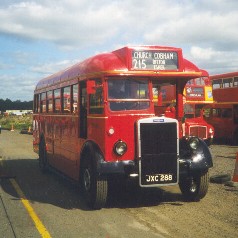
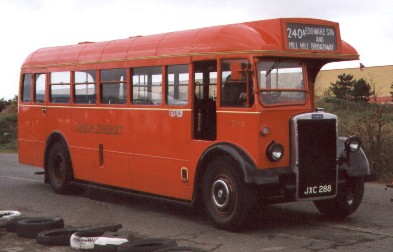
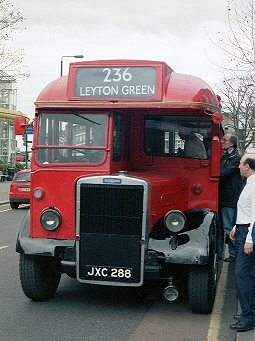
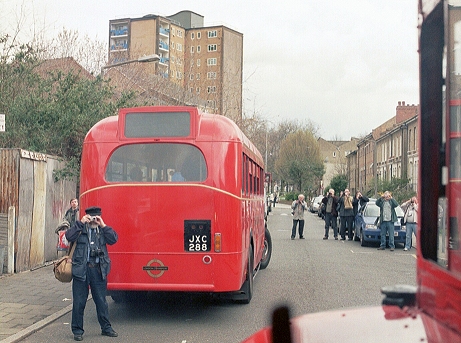
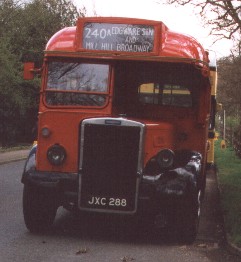
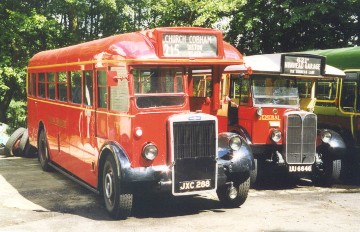
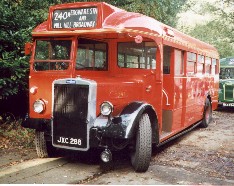
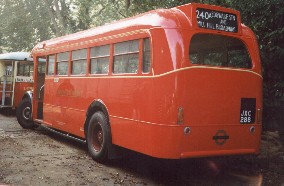
 TD1-131: bus histories
TD1-131: bus histories Ian's Bus Stop
Ian's Bus Stop T contents
T contents TDs
TDs